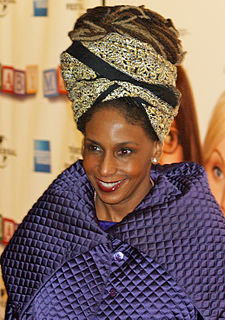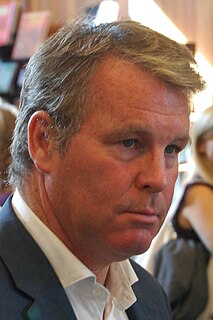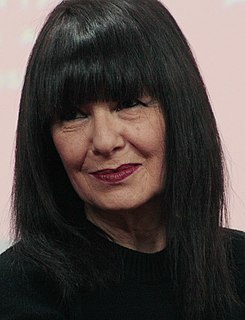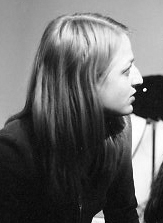
A curator is a manager or overseer. When working with cultural organizations, a curator is typically a "collections curator" or an "exhibitions curator", and has multifaceted tasks dependent on the particular institution and its mission. In recent years the role of curator has evolved alongside the changing role of museums, and the term "curator" may designate the head of any given division. More recently, new kinds of curators have started to emerge: "community curators", "literary curators", "digital curators" and "biocurators".

Renee Cox is a Jamaican-American artist, photographer, lecturer, political activist and curator. Her work is considered part of the feminist art movement in the United States. Among the best known of her provocative works are Queen Nanny of the Maroons, Raje and Yo Mama's Last Supper, which exemplify her Black Feminist politic. In addition, her work has provoked conversations at the intersections of cultural work, activism, gender, and African Studies. As a specialist in film and digital portraiture, Cox uses light, form, digital technology, and her own signature style to capture the identities and beauty within her subjects and herself.

Stephen Snoddy is a British artist and gallery director.

RoseLee Goldberg is an American-based art historian, author, critic and curator of performance art. She is most well known as being the founder and director of Performa, a performance art organisation. She is also currently a Clinical Associate Professor of Arts Administration at New York University.
Andrew Berardini is an American writer known for his work as a visual art critic and curator in Los Angeles. Described as "the most elegant of all art critic cowboys", Berardini works primarily between genres, which he describes as "quasi-essayistic prose poems on art and other vaguely lusty subjects."
Peter Sarkisian is an American video and multimedia artist who lives and works in Santa Fe, New Mexico.
Judith E. Stein is a Philadelphia-based art historian and curator, whose academic career has focused on the postwar New York art world. She has written a biography of the art dealer Richard Bellamy, as well as feature articles regarding artists including Jo Baer, Red Grooms, Lester Johnson, Alfred Leslie and Jay Milder.

Sue de Beer is a contemporary artist who lives and works in New York City. De Beer's work is located at the intersection of film, installation, sculpture, and photography, and she is primarily known for her large-scale film-installations.
Ecological art is an art genre and artistic practice that seeks to preserve, remediate and/or vitalize the life forms, resources and ecology of Earth. Ecological art practitioners do this by applying the principles of ecosystems to living species and their habitats throughout the lithosphere, atmosphere, biosphere, and hydrosphere, including wilderness, rural, suburban and urban locations. Ecological art is a distinct genre from Environmental art in that it involves functional ecological systems-restoration, as well as socially engaged, activist, community-based interventions. Ecological art also addresses politics, culture, economics, ethics and aesthetics as they impact the conditions of ecosystems. Ecological art practitioners include artists, scientists, philosophers and activists who often collaborate on restoration, remediation and public awareness projects.
Amy Feldman is an American abstract painter from Brooklyn, New York.
Ecovention was a term invented by Amy Lipton and Sue Spaid in 1999 to refer to an ecological art intervention in environmental degradation. The Ecovention movement in art is associated with land art, earthworks, and environmental art, and landscape architecture, but remains its own distinct category. Many ecoventions bear tendencies similar to public works projects such as sewage and waste-water treatment plants, public gardens, landfills, mines, and sustainable building projects.
Phyllis Baldino is an American visual artist whose art engages in a conceptual practice that merges performance art, video art, sculpture, and installation in an exploration of human perception. Her single-channel videos are distributed by Electronic Arts Intermix in New York, NY. She currently lives and works in Brooklyn, New York.
Joyce J. Scott is an African-American artist, sculptor, quilter, performance artist, installation artist, print-maker, lecturer and educator. Named a MacArthur Fellow in 2016, and a Smithsonian Visionary Artist in 2019, Scott is best known for her figurative sculptures and jewelry using free form, off-loom beadweaving techniques, similar to a peyote stitch. Each piece is often constructed using thousands of glass seed beads or pony beads, and sometimes other found objects or materials such as glass, quilting and leather. In 2018, she was hailed for working in new medium — a mixture of soil, clay, straw, and cement — for a sculpture meant to disintegrate and return to the earth. Scott is influenced by a variety of diverse cultures, including Native American and African traditions, Mexican, Czech, and Russian beadwork, illustration and comic books, and pop culture.
Helen Anne Molesworth is an American curator of contemporary art.

Natasha Boas is a French-American contemporary art curator, writer, and critic. She has taught art history and curatorial studies at Yale, Stanford, and the San Francisco Art Institute. Her exhibition on the Modernist Algerian artist, Baya Mahieddine Baya: Woman of Algiers in 2018 at the Grey Art Gallery at New York University garnered her international critical attention. In 2017 she was featured in Lynn Hershman Leeson's Vertighost, playing the role of herself as an art historian. She also authored the Facebook Artist in Residence book on the recent history of Art and Technology in the Bay Area for the 5th anniversary of Facebook's artist-in-residency program. An adjunct professor at the California College of the Arts, she is an expert in the art of California countercultures, the modernist avant-garde, the Mission School and Outsider artists.
Moira Dryer (1957–1992) was a Canadian artist known for her abstract paintings on wood panel.

Maya Hayuk is an internationally exhibited American artist living and working in Brooklyn, New York. She is best known for the bold geometric patterns she employs in large-scale murals.
Paul Henry Ramirez is an American contemporary artist known for his biomorphic abstractionist paintings. As his figural based paintings evolved to include geometrics, in 2010, Ramirez coined the term "biogeomorphic abstraction" to describe his own bold painting style, a fusion of biomorphic and geometric forms. He also gained notability for his site-specific installations as his paintings began to expand outside the confines of the canvas edges onto the walls of the gallery space. These site-specific installations gradually evolved to encompass the whole gallery space, creating a full environmental experience. Donald Kuspit, scholar and art critic, describes Ramirez as “an important new kind of abstract painter. .. an abstractionist playing with color and form to exciting imaginative effect.”
Rachel Foullon is an American artist and curator. Foullon has exhibited her works in galleries and museums nationally and internationally in addition to organizing and curating multiple exhibitions across the United States. She is also the Director of Operations at Monkeypaw Productions.
Jane Hart is an American curator, gallerist and artist in New York City. She has worked as an art curator since 1993, having been a gallery owner in Los Angeles and Miami, and a contemporary art professional in Manhattan and London. As an artist she has exhibited internationally, with solo exhibitions in South Florida and Cleveland, Ohio. Her specialty is contemporary collage, with works in private collections in the United States and abroad.






